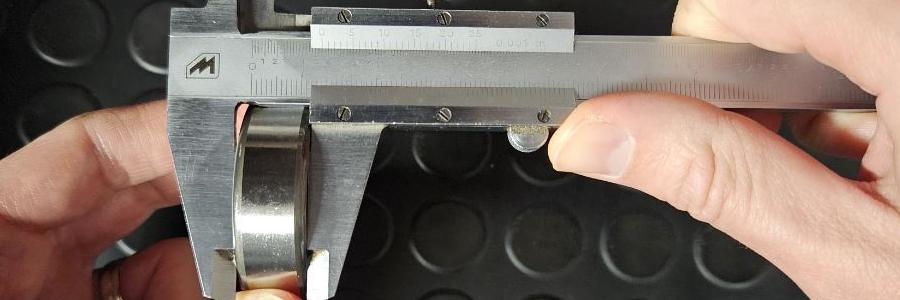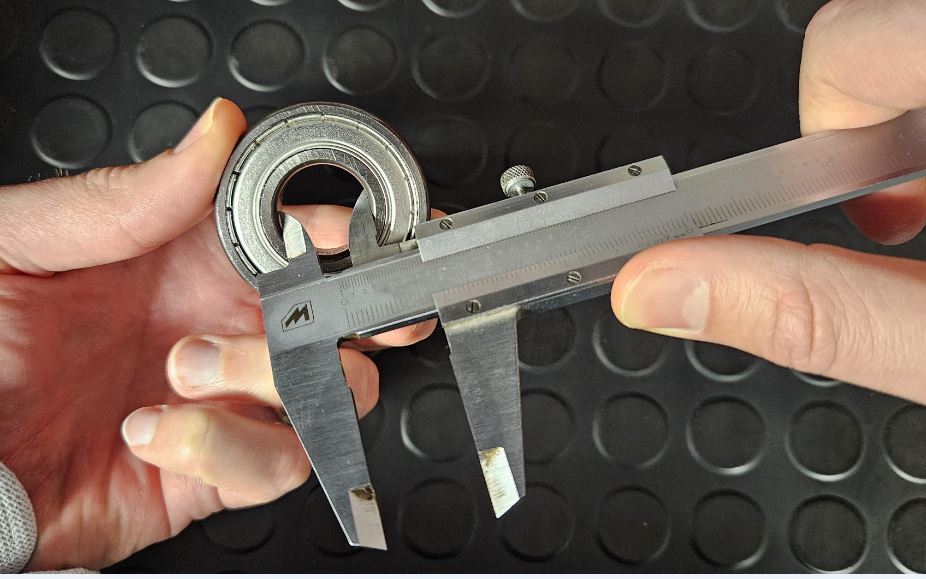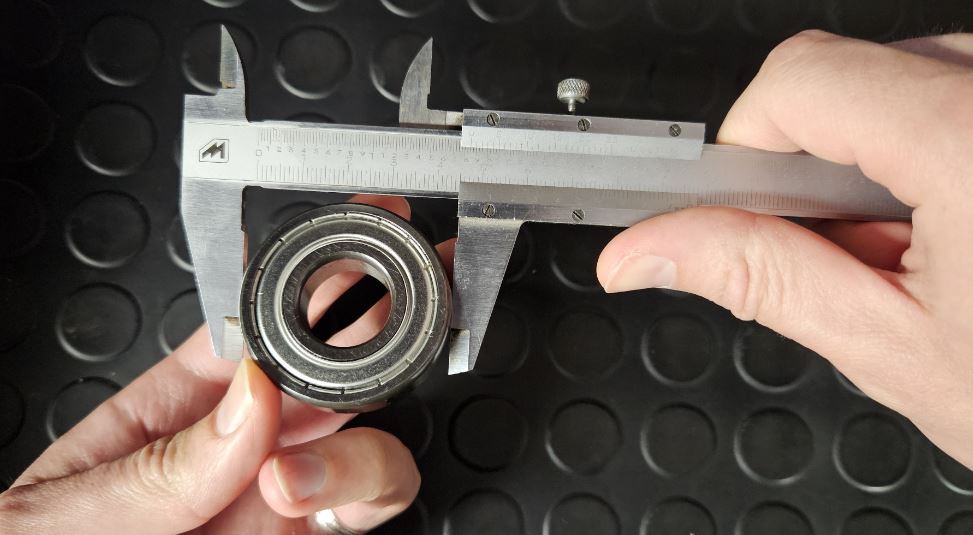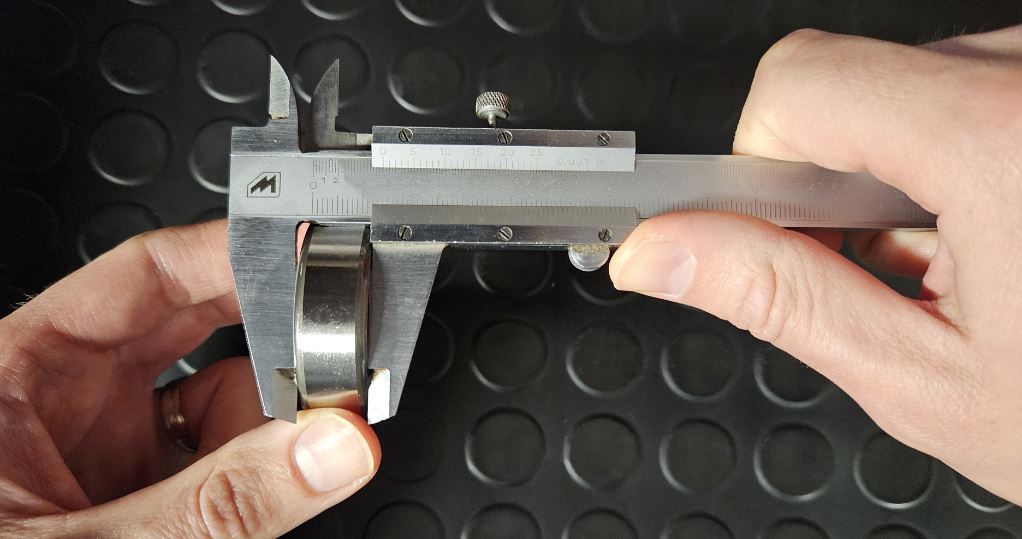How to Measure Bearings: A Comprehensive Guide

To measure bearings accurately, it is best to use a vernier caliper and follow specific steps. The basic dimensions of a bearing are the inner diameter, the outer diameter, and the width, which must be measured.
Repeat the measurements of each dimension several times and make a note of them. Most bearings have full mm or inch dimensions. So if you measure 9.95 mm it is most likely a 10 mm dimension. Similarly, if you measure 9.5 mm it is most likely a 3/8 inch (9.53 mm) dimension.
Once you have measured all three dimensions, compare them with those in the bearing catalogs or use the advanced bearing finder where you can enter the dimensions to find the correct bearing designation.
In this comprehensive guide, we will get into the details of bearing measurement, covering best practices, industry norms, and standards.
Whether you are a seasoned engineer, a DIY enthusiast, or a curious beginner, mastering the art of measuring bearings is essential for selecting the correct bearing.
Understanding Bearings and Their Importance
Before getting into measurement techniques, let's briefly understand what bearings are and why they are crucial in various applications.
Bearings are mechanical components that enable rotational motion by reducing friction between moving parts.
They come in various types, including the popular ball bearings and roller bearings, each designed to handle specific loads and operating conditions.
Bearings are found in a myriad of machinery and equipment, from automobiles and industrial machinery to household appliances and power tools.
Bearing Measurement Steps
Bearing measurement must be done with high-precision measuring tools, a vernier caliper being the most common option. To ensure the measurement is accurate and repeatable, you have to keep your measuring tools calibrated and in good condition.
Once your tool is properly calibrated according to the manufacturer's recommendations, you can move on to the following steps.
1. Inner Diameter (ID)
To measure the diameter of the inner bore of the bearing, you can use the outer anvils of the caliper, an inside micrometer, a bore gauge, or even a high-quality steel ruler.
When using these tools, you need to make sure the anvils or jaws are placed at a right angle to the bore to obtain a correct measurement.
Again, take measurements at multiple points to account for any irregularities.
Figure 1 Measuring bearing inner diameter
2. Outer Diameter (OD)
Use the jaws of a caliper and place them around the bearing to measure the diameter of the outer surface of the bearing.
When closing the jaws, make sure that you get a good fit rather than a tight one.
Take measurements at multiple points around the circumference to ensure accuracy.
Figure 2 Measuring bearing outer diameter
3. Width (W)
Determine the width of the bearing by measuring the distance between the two opposing surfaces of the bearing using a caliper or micrometer.
Put the opposing faces of the bearing between the anvils or the jaws and close them until you get a good fit as you did when measuring the outer diameter.
Figure 3 Measuring bearing width
4. Overall Height (H)
For bearings with a non-standard shape, measure the overall height from the bottom to the highest point using a height gauge or depth micrometer.
Notice that most bearings have full mm or inch dimensions. So if you measure 9.95 mm it is most likely a 10 mm dimension. Similarly, if you measure 9.5 mm it is most likely a 3/8 inch (9.53 mm) dimension.
Importance of Bearing Measurements
Accurate measurement of bearings is paramount for several reasons. Here are some of the most relevant for you to consider.
1. Fit and Functionality
Proper measurement ensures the bearing fits precisely into its intended housing or shaft, maximizing performance and longevity.
2. Interchangeability
Standardized measurements allow for the interchangeability of bearings, simplifying maintenance and replacement procedures.
Industry Norms and Standards:
Several industry organizations and standards bodies establish norms and standards for bearing measurements. Some of the most commonly referenced standards include:
1. ISO (International Organization for Standardization)
ISO standards, such as ISO 492 and ISO 15, specify dimensional and geometric requirements for rolling bearings, ensuring global compatibility and interchangeability.
2. ABMA (American Bearing Manufacturers Association)
Working with the American National Standards Institute (ANSI), ABMA standards provide guidelines for the design, manufacturing, and measurement of bearings, particularly in the United States.
3. DIN (Deutsches Institut für Normung)
DIN standards, such as DIN 620 and DIN 625, are widely used in Europe and establish requirements for the dimensions and tolerances of rolling bearings.
Best Practices for Bearing Measurement
To ensure accurate and reliable measurements, consider the following best practices:
1. Use High-Quality Instruments: Invest in precision measuring instruments, such as vernier caliper, micrometers, and gauges, to obtain accurate measurements.
Figure 4 Vernier caliper for bearing measurement
2. Take Multiple Measurements: Take measurements at multiple points and orientations to account for any variations or irregularities in the bearing's dimensions.
3. Document Measurements: Record all measurements along with relevant information, such as bearing type, part number, and manufacturing date, for future reference and traceability.
4. Define Bearing Part Number: Once you have measured all dimensions and defined bearing type and bearing seals compare them with those in the bearing catalogs or use the advanced bearing finder where you can enter the dimensions, select bearing type, and seal to find the correct bearing designation.
Conclusion
In conclusion, mastering the art of measuring bearings is essential to find proper bearings for mechanical systems.
By following industry norms, standards, and best practices, engineers, technicians, and enthusiasts can navigate the complexities of bearing measurement with confidence and precision.
As you embark on your journey of precision engineering, remember that accurate measurements are the cornerstone of excellence in mechanical design and operation.
For a wide selection of high-quality bearings and mechanical components, visit our e-commerce store.































Leave a Comment
Your email address will not be published. Required fields are marked *